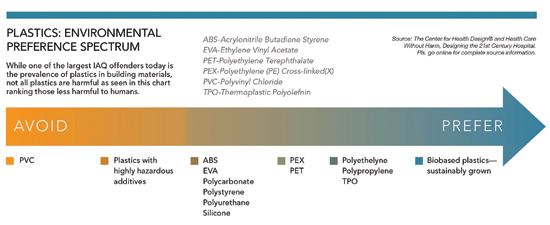Designed, Sealed, Delivered - IAQ and the Building Enclosure
This listing shows the major types and enclosure sources of indoor air pollutants. However, since many materials and products are manufactured using many ingredients, buildings can yield thousands of chemicals, some of which we do not have complete information on.
Of course the reason to be concerned about any of these items is the health effects on people. These can include respiratory health problems including the growing occurrences of asthma in the U.S. Poor indoor air quality has also been linked to cancer and effects on reproductive systems and development, particularly in school buildings. With the health, safety, and welfare in mind of building occupants, it becomes imperative then, that architects and other design professionals address these potential health risks and exposures in buildings, including the enclosure materials. Specifications that require use of materials with low or no VOCs and no added formaldehyde certified by strong emissions testing protocols can greatly improve indoor air quality. Further, moisture control must be properly addressed since failures can compound IAQ by creating mold, mildew, or other conditions which may complicate any existing health issues of occupants.
 |
Source: Rossi, Mark and Tom Lent, “Creating Safe and Healthy Spaces: Selecting Materials that Support Healing” in Designing the 21st Century Hospital, Center for Health Design & Health Care Without Harm, 2006, page 66. |
Indirect Enclosure Impacts on IA Q
Beyond the direct impacts from pollutants that a building enclosure can have on IAQ, there are indirect impacts that must be addressed since they can be critically important as well. Specifically, IAQ issues are affected by temperature, air pressure, and moisture content which are controlled by both the building envelope and HVAC system as discussed further.
Air movement. Air will move through a building enclosure in various ways, both desirable and undesirable. Unwanted air leakage occurs when air moves through some portion of the building enclosure into cavities or other places within the assembly. Since no building construction is perfect, it is safe to say that all building enclosures leak air. The only question is how much air do they leak and where the leaks are located. Tight buildings will leak a little while others can leak a lot. The key to good performance is controlling that flow and minimizing leaks.
There are multiple areas of concern regarding air leakage. First, bringing in some fresh air is good, sometimes for ventilating cavity spaces or simply allowing the building to “breathe.” But unwanted or excess air leakage can gather, carry, and deposit pollutants either from outdoors or within the assembly, causing potential issues. So when there is leakage, it can actually bring pollutants in, to add to the ones that are already in the materials, thus exacerbating the problem. Fine particles are examples of pollutants that we don’t want to collect in the interior space. Second, using the enclosure to keep contaminants away from people is desirable, but if the enclosure is too tight it can create one set of problems while not building the enclosure tight enough can create another set of problems. Third, moving indoor pollutants out of the building is essential so some controlled way of moving air is needed.
The usual measure of air infiltration is the number of times within an hour that the volume of air in a building can be replaced. This is measured simply as air changes per hour (ACH). Depending on the building type and the circumstances, the preferred ACH level could be very low (less than .5 ACH) to something higher (over 1.0 ACH). The actual level will be determined by the tightness of the air barriers in the envelope, temperature, and the air pressure levels inside and outside of the building. Air pressure is commonly measured in an SI standard unit called a pascal (Pa) named after the French mathematician Blaise Pascal and commonly used for barometric pressure measurement.
Compared to the more familiar pounds per square inch (psi), it takes about 6,895 pascals to equal 1 psi, hence it is a very precise measurement of pressure. Air infiltration can be measured in buildings by using a large fan to pressurize a specific space and then measure the differential in Pa between the inside and outside. Using this information, even relatively small leakage rates can be determined and addressed.









